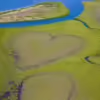Pohnpei Travel Guide
Welcome to the taste2travel Pohnpei Travel Guide!
Date Visited: February 2017
Introduction
After an hour of climbing in the sweltering, humid, heat – under the direct glare of the tropical sun – I’d finally made it to the summit of Sokehs ridge – a point marked by a very unceremonious communications tower.

View of the fringing reef that protects Pohnpei from Sokehs Ridge.
From here I had a panoramic view of the northern tip of Pohnpei. In the valley below, the capital – Kolonia – was slowly being enveloped by a fierce tropical storm. Like a deer staring into the headlights, I stood and watched as the storm clouds slowly rolled across the landscape towards me.
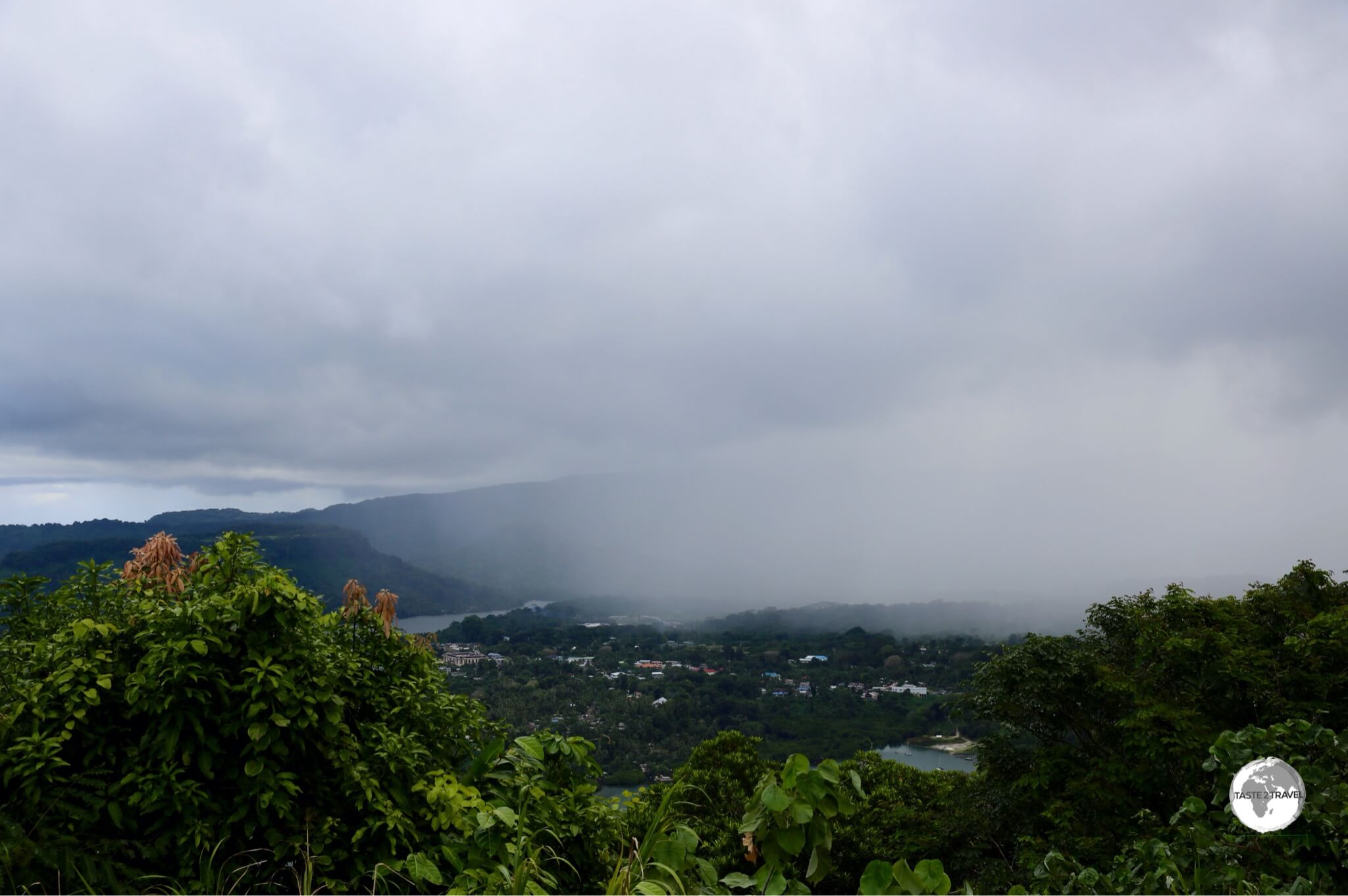
A storm moving over Kolonia, the capital of Pohnpei, as seen from Sokehs ridge.
Then the inevitable happened – first one drop, then another, then the heaven’s opened up – but after the long, hot climb, all that cool water was so refreshing. I had found a sheltered place for my camera bag, but as for me – I stood out in the open with my arms and mouth open, getting soaked and slurping the tropical rainwater.
After the storm cleared, I had a magnificent view of Sokehs rock, a 100m high exposed basalt volcanic plug that shoots up out of the lush green landscape and is the most striking feature of Pohnpei’s topography. The island gets it’s name from this feature – “upon (pohn) a stone altar (pei)”.
Just a few days earlier I had had a bird’s eye view of the rock from my seat (32D) on board United Airlines’ Island Hopper (UA154) as we passed by the rock on our final approach to Pohnpei airport.

Nature abounds on Pohnpei – the ‘garden of Micronesia’.
Pohnpei (formerly ‘Ponape’) is one of the four states, which comprise the Federated States of Micronesia (FSM) and bills itself as ‘the Garden of Micronesia‘. You don’t need to spend much time on the island to realise this is not some over-hyped slogan created by local tourism officials.
Due to it being one of the wettest places on earth (annual recorded rainfall exceeding 76-cm/ 300-in), Pohnpei is full of lush, tropical, vegetation, a place where colourful, flowering plants frame every view. Visiting Pohnpei is like holidaying on an over-sized botanical garden – it’s that beautiful.

These handmade decorations are made by a woman’s coop in Kolonia.
The island is surrounded by a fringing reef, which provides protection and so much more for the island. Surfing is popular on the reef and more and more intrepid surfers are finding their way to this remote island to ride the famed waves of Palikir pass. The reef also offers diving, snorkeling and fishing opportunities.

The view of the fringing reef which surrounds Pohnpei from my seat on United Airlines’ Island Hopper.
Almost all services on Pohnpei are located in the capital of Kolonia so this is the place to base yourself during your visit. The town has a population of 6,000 (almost the entire population of neighbouring Kosrae) so if you are coming from quiet Kosrae you will notice the hustle and bustle. There’s one road which circumnavigates the island and provides access to all the sights of interest.
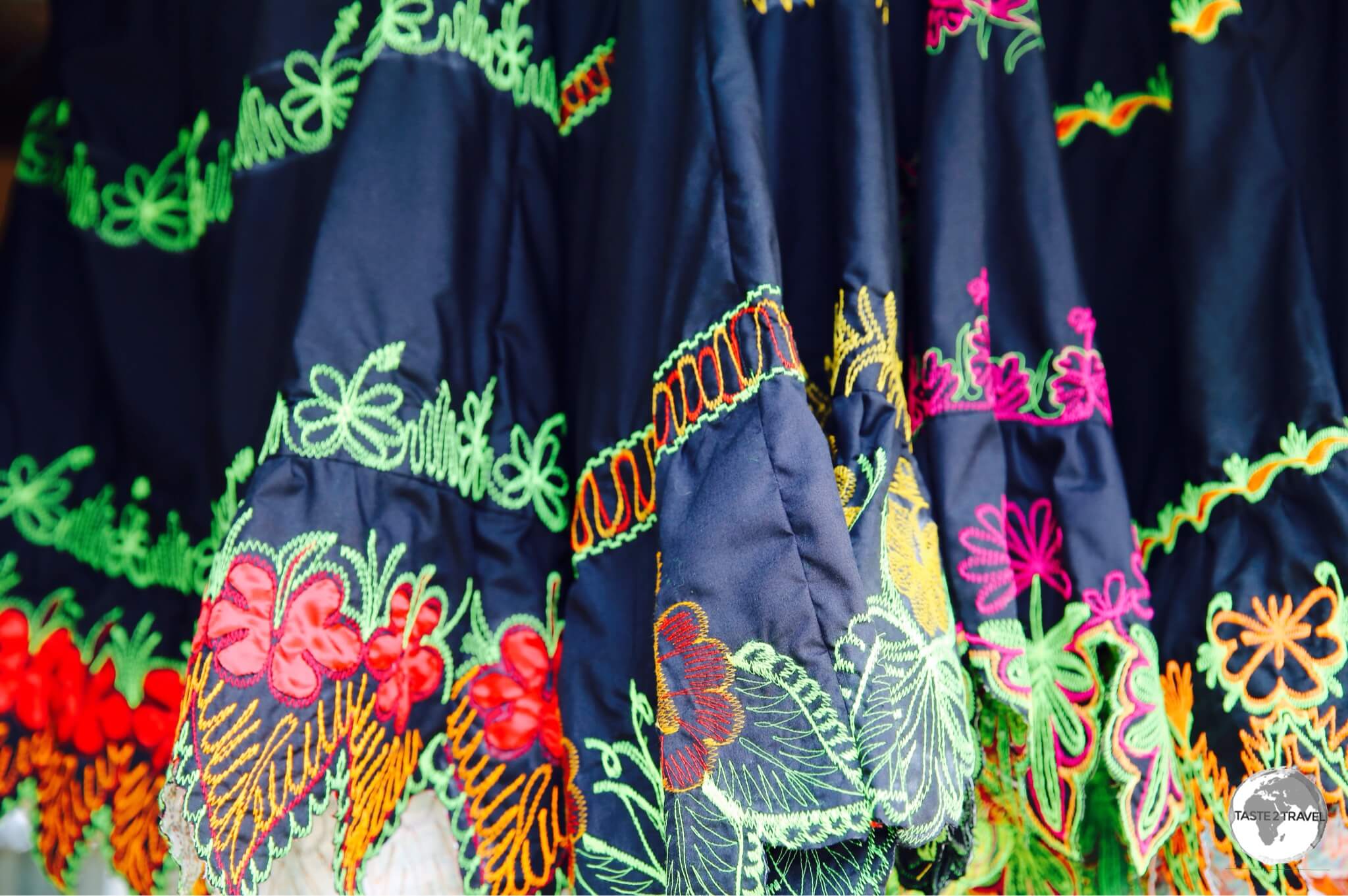
Traditional embroidered ‘Pohnpei’ dresses. These are worn by almost every girl on the island.
The island has many natural attractions and many good restaurants and bars in Kolonia – enough to keep you busy for a few days.

Very cute! Flower Girl on Pohnpei.
Location
Federated States of Micronesia
Pohnpei is located in the middle of nowhere, midway between Hawaii and The Philippines. It’s part of the Federated States of Micronesia, being located at the eastern end of the Caroline Islands group.

Distance marker in Kolonia – everywhere is a long way from Pohnpei.
The island is volcanic and mountainous, with those mountains being covered in verdant rainforests and cascading waterfalls.
History
Archaeologists estimate that people came to Pohnpei between 2,000 and 3,000 years ago from Southeast Asia. The first European contact was with the Spanish in 1529.
The Spanish made the island part of the Spanish East Indies (along with The Philippines) and founded the city of Santiago de la Ascension. This city was later renamed Colonia (Spanish for colony) which was in turn renamed to today’s Kolonia.

The elusive Pohnpei Lorikeet seen on Sokehs ridge.
Rule of the island passed from Spain to Germany to Japan then (following the defeat of the Japanese during WWII) to the United States. The US administered the island (under UN auspices) as part of the Trust Territory of the Pacific Islands until 1986 at which point the island obtained independence as one of four states (along with Yap, Chuuk, and Kosrae) comprising The Federated States of Micronesia.

Shipping containers on Pohnpei are used in creative ways.
The standout historical feature of the island (and it’s top attraction) is the impressive ancient ruins of Nan Madol – the most impressive ruins complex in the Pacific. For more on Nan Madol, refer to the sightseeing section below.
Flag

The flag of Micronesia.
The flag of the Federated States of Micronesia (FSM) was adopted on 30 November 1978. The blue field represents the Pacific Ocean, while the four stars represent the states in the federation: Chuuk, Pohnpei, Kosrae and Yap.
Currency

The US Dollar.
In centuries past, the islands of FSM, notably Yap, used stone currency, which was referred to as “Rai” or “Fei”. Impossibly large and too heavy to carry, this traditional currency, which seemed to be more suited to a giant, was crafted from Calcite, which was carved into doughnut-shaped disks.

Yap Stone Currency.
Source: https://medium.com/the-mission/the-island-of-yap-and-the-idea-of-money-9f570421d854
Today, along with all former members of the Trust Territory of the Pacific Islands, the official currency of FSM is the US dollar which is so much easier to carry.
Betel-Nut

Betel-Nut for sale at a shop in Kolonia.
Betel nut is a popular stimulant on Pohnpei and can be found in shops and markets across the island.
A form of local chewing tobacco, the betel nut is split open and powdered with lime, wrapped with pepper plant leaf and then placed in the mouth where it is chewed. Am indicator of beetle nut use is an orange mouth a result of chewing
It’s a practice found throughout the FSM, but Pohnpei and Yap have it in abundance and it is a relatively important exported cash-crop for the local economies.
Sights
With the exception of Nan Madol and a few colonial relics scattered around Kolonia, most sights on the island are of the natural kind. The other joy of travelling on Pohnpei are the locals. Without exception, they are friendly, warm and welcoming.
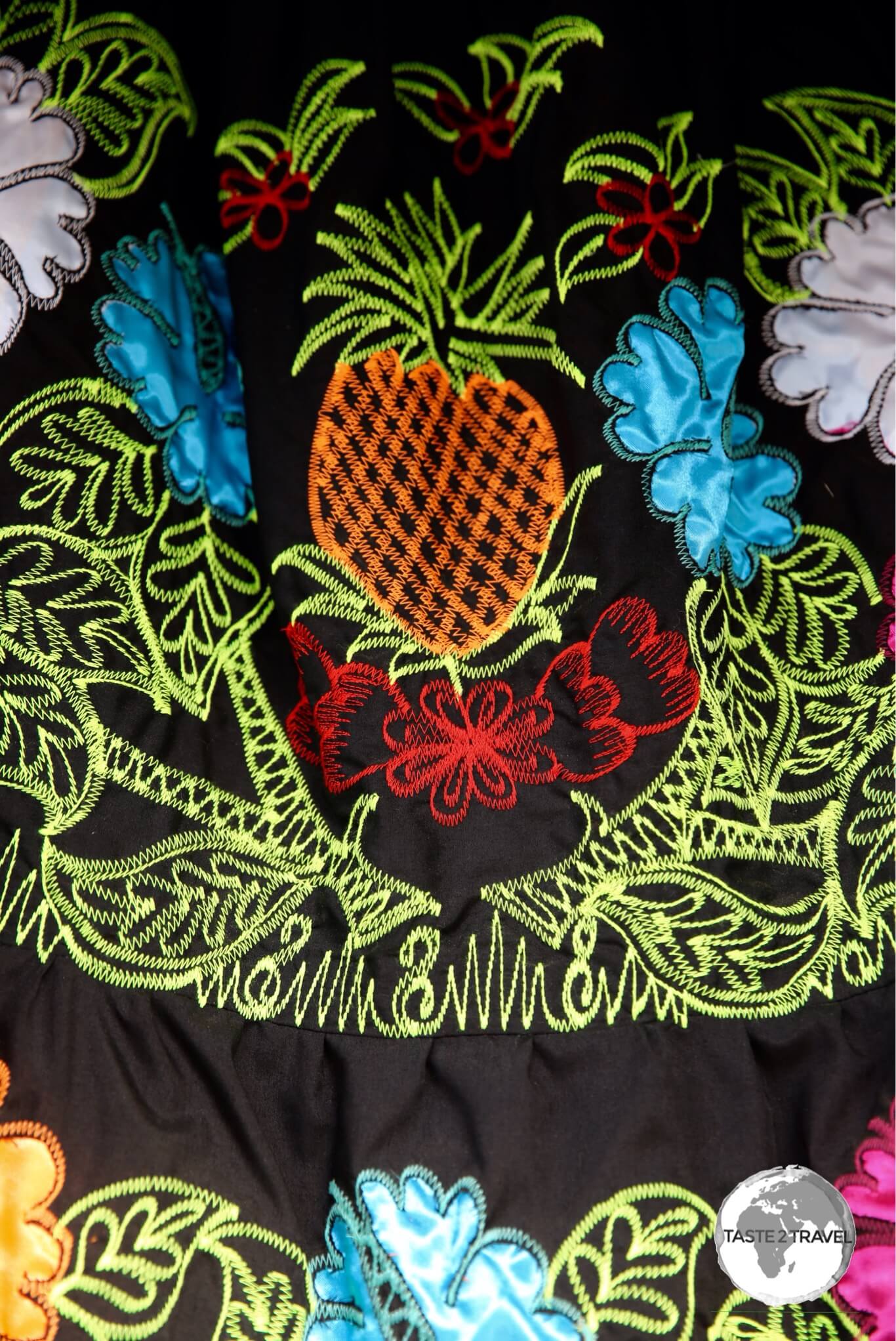
Traditional embroidered ‘Pohnpei’ dresses.
Due to the complete lack of transport on the island you will need to hire a car if you wish to explore beyond Kolonia (you should definitely get out of town). There is one ring road around the island which is 130-km in length. You can cover all sights in one full day.
There are very few petrol stations outside of Kolonia so better to have a full tank before leaving town. I’ve covered the sights as you will approach them if you travel in an anti-clockwise direction around the island, with Kolonia at the 12 o’clock position.

No shortage of smiles on Pohnpei.
Kolonia
With a population of 6,000, Kolonia is the capital and main city of Pohnpei. With a few roads, a handful of shops and all of the (limited) tourist services on the island, the town is the centre of action but very quiet and relaxed. There are few sights (a German clock tower and a Spanish stone wall) but it is a pleasant place to spend an hour or two exploring.
Sokehs Ridge

Sokehs Rock, a gigantic exposed basalt volcanic plug is the most striking feature of Pohnpei’s topography.
Overlooking Kolonia is the impressive Sokehs Ridge. The hike up to the top of the ridge offers a good workout and is best done early morning or late afternoon. If you have a car you can park it in the car park of the police station at the start of the tarmac road which leads part way up the ridge.
Eventually the tarmac road becomes a dirt road (still passable in a 4WD) before reaching a level ridge from which point you must walk. This is the start of a very steep trail which climbs up to the ridge from where you will have the most amazing views of Kolonia and the Pacific. This is a long, sweaty slog on a remote ridge so ensure you are carrying ample water.

Japanese war memorial on Sokeh’s ridge.
Once you reach the top of the ridge (you’ll probably have the ridge to yourself) you can follow trails which take you to Japanese WWII ruins and eventually onto the communications tower from where you have panoramic views of the northern side of the island.
Palikir

The FSM capital, Palikir, is located in a small administrative enclave on a side road of Pohnpei.
Just 8-km south of Kolonia is a right-hand turn off the main road, which leads to Palikir – the capital of the Federated States of Micronesia.

Government buildings in sleepy Palikir.
The capital is a tiny planned enclave of little consequence, with uniformly designed buildings arranged around a small park area. I visited on a weekend and had the place to myself – there was no sign of life – no cafes, restaurants or services of any kind.
Nan Madol

The impressive walls of Nan Madol.
Located in a remote coastal setting, about 90 minutes south of Kolonia (along the east coast), Nan Madol is the one ‘must see’ attraction on Pohnpei. If this was anywhere else in the world you would be lining up to buy a ticket and jostling with hoards of tourists who would be constantly photo-bombing your shots.
But here – on remote Pohnpei – you will probably have the sight to yourself. The ruined city is very impressive and extensive, but the addition of being in such a remote place makes a visit a truly unique experience.
You reach the ruins after a 10 minute walk along a track, which leads you through a steamy mangrove forest. You have to pay three different property owners an ‘access’ fee along the way, the last payment (US$5) is to the man who transports you across a narrow channel in his kayak, dropping you at the main entrance to the ruins.

A diagram of the sprawling Nan Madol complex.
It is believed Nan Madol was constructed by the same people who built the Leluh site on Kosrae (for more on that refer to my Kosrae blog). The city was constructed in a lagoon and consists of a series of small artificial islands (nearly 100) spread over an area of 1.5 km by 0.5 km.
There is no public transport to Nan Madol, you can reach the ruins either by car or by joining a tour.
Kepirohi Waterfall

Kepirohi waterfall is located a short drive from Nan Madol.
Located north of the Nan Madol turnoff (look for the roadside sign) is this beautiful Basalt waterfall. To access the falls, you first pay an ‘access’ fee to the property owner who occupies a shed by the main road.
You then have a 5 minute walk along a lush, forested trail to the falls. This is a great place to cool off after a sweaty day of sightseeing so don’t forget your swimmers.
Accommodation
7-stars Inn
Like everything else, Kolonia is where it’s at in terms of accommodation options on Pohnpei. I stayed in the conveniently located 7-stars Inn, a short walk from the downtown area. Rooms here are spacious and comfortable and include free Wi-Fi.
One of the more popular restaurants in town, The Riverside Restaurant, is located in the basement of the hotel, along with one of the only sports bars on the island. The hotel provides a free airport shuttle service.
Joy Hotel
Another mid-range option in downtown Kolonia is the Joy Hotel which is run by a Japanese family.
The Suzuki family offers basic rooms and a restaurant which, naturally, specialises in Japanese cuisine.
Mangrove Bay Hotel
Another popular (but more expensive) option is the Mangrove Bay hotel. The hotel is a little further from downtown Kolonia but is more relaxing and includes a PADI dive shop and boat transport for surfers wishing to catch a ride to Palikir pass. For all hotels it’s best to book using booking.com
Eating Out

The fiery Pohnpei pepper is grown in the south of the island at a garden owned by Sei.
There are plenty of wonderful restaurants, bars and cafes on Pohnpei – all located in Kolonia.
One place which deserves a special mention is the friendly, Japanese owned Sei Pepper shop. Mr Sei grows his pepper on a farm located on the southern side of Pohnpei, however the only place to buy his pepper is from his shop on the main street of Kolonia (located a short walk from the 7-stars Inn).

The delicious organic Pohnpei coffee available at Sei.
The cafe is a meeting place for the local Japanese community who come together to sip the local Pohnpei coffee, which has a very bold, robust flavour. Attached to the cafe is a curry house where you can sample tasty curries made with Pohnpei pepper and other locally grown spices.

The amazing pepper donuts at Sei Cafe – a fiery experience!
A specialty of the restaurant are the fiery Pohnpei Pepper Donuts, which you can wash down with a cup of Pohnpei coffee.
The Japanese Community in Micronesia

The Sei cafe serves as a meeting place for the Japanese community on Pohnpei.
Japan has enjoyed close ties with Micronesia throughout history, and, at the time of WWII in 1942, there were 96,000 Japanese who called Micronesia home.
After the war, the Japanese population were repatriated back to Japan, however most people of mixed Japanese–Micronesian ethnicity remained in the islands and constituted a substantial percentage in the islands’ population. They became assimilated with the Micronesians, and in all official census they are identified by their Micronesian heritage.
If you’re interested to learn more about the Japanese connection to Micronesia, the Sei cafe in Kolonia is a good place to start your enquiries.
There are numerous restaurants in Kolonia – my favourite was the restaurant at the Joy Hotel. This restaurant serves amazing Japanese food (including the freshest sushi and sashimi) at very reasonable prices. All ingredients were fresh and nicely presented. I ate here more than once and would especially recommend ordering the ‘Joy special’.
For more upscale dining, there is the waterfront restaurant at the Mangrove Bay hotel.
A refreshing drink throughout FSM is iced tea – always made from fresh black tea, which is served in a glass with lots of cool ice. The sweetener (always simple syrup) is served on the side so you can decide on your level of sweetness.
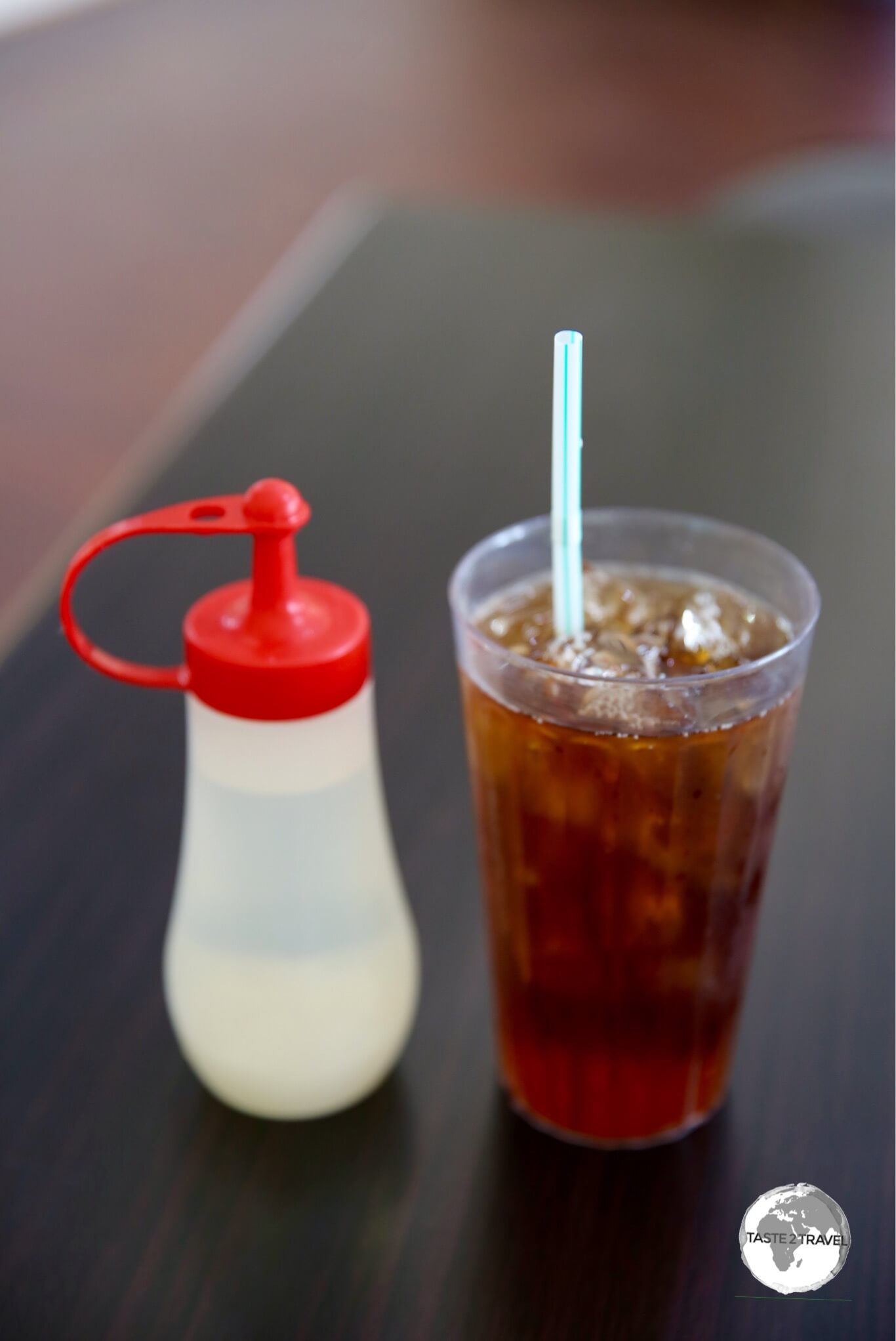
Iced Tea served with simple syrup on the side in a cafe in Kolonia.
Visa Requirements
Some nationalities require visas for the Micronesia – check your visa requirements prior to arrival.
Getting There

Boarding United Airlines’ Island Hopper (UA154) at Pohnpei airport.
By Air

Arriving at Pohnpei Airport.
Flights to Pohnpei arrive at Pohnpei International Airport (IATA: PNI), .
If you are seated on the right side of the plane you will have a spectacular view of Sokehs Ridge on the final approach. For more on Pohnpei airport, refer to my Central Pacific Island Hopping blog.
Like many islands within the region, commercial air service is rather limited due to small population and tourist traffic.
The following airlines provide connections to/from Pohnpei (Updated: August 2024):
- Caroline Islands Air (Charter flights only) – flies to/ from Chuuk, Enewetak, Kapingamarangi, Kosrae, Mwoakilloa Airfield, Nukuoro, Pingelap, Sapwuahfik, Mortlock Islands Airfield (Ta), Woleai, Yap
- Nauru Airlines – flies to/ from Palau, Majuro, Nauru, Tarawa
- United Airlines – flies to/ from Chuuk, Guam, Honolulu, Kosrae, Kwajalein, Majuro

A view of the terminal at Pohnpei airport.
Nauru Airlines

Nauru Airlines route map – as of August 2024.
Nauru Airlines offer regular connections to many destination in the Central Pacific region, including Pohnpei, from their base at Brisbane International Airport.
An especially useful connection, for those already travelling in the South Pacific, is the airline’s regular flight from Nadi (Fiji) which offers connections to countries in the Central Pacific.
Email address of the Brisbane office: book@ourtravel.com.au
Getting Around
Bus
There are no buses on Pohnpei.
Taxi
There are a few taxis available in Kolonia.
Car

The license plate of my rental car on Pohnpei.
There are very few rental companies on Pohnpei but you will need a car if you wish to explore on your own.
I hired a car through my hotel at US$65 a day.
Although expensive – I had a very nice, brand new, KIA Sportage – perfect for the bumpy, potholed roads outside of Kolonia. I felt like a ‘boss’ cruising around in my SUV and definitely didn’t want to give it up but United couldn’t fit it on the island hopper flight. :-))
As mentioned previously, fuel supply outside of Kolonia is limited so best to ensure you have a full tank prior to leaving town. If you do get stuck you can find roadside stalls selling fuel by the gallon ($5/ gallon).
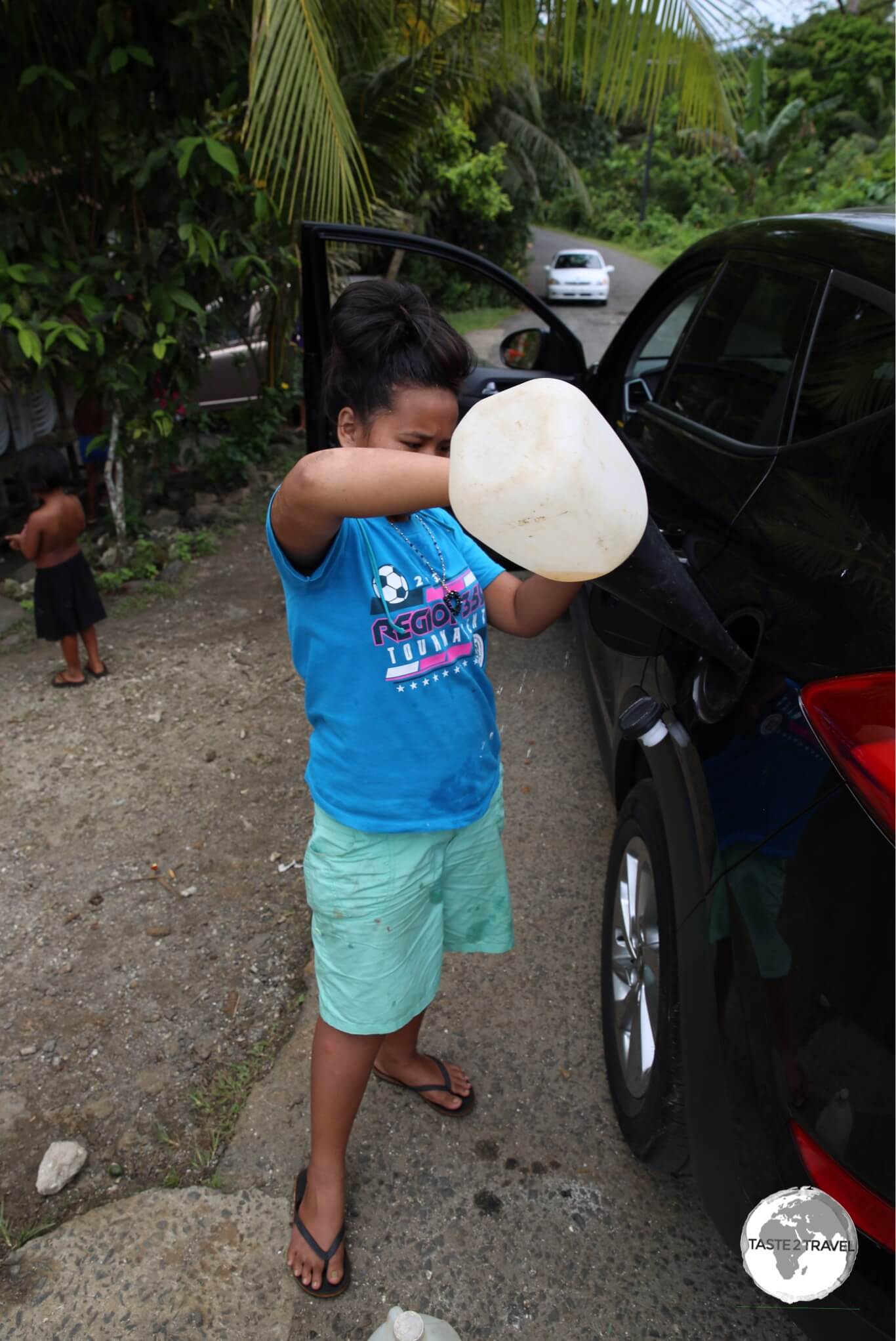
I saw just one petrol station outside of Kolonia. Elsewhere you can purchase fuel from small roadside stalls.
That’s the end of my Pohnpei Travel Guide.
Safe Travels!
Darren
Follow me on Instagram:
[instagram-feed feed=1]
Further Reading
Other travel reports from the Pacific region:
Pohnpei Travel Guide Pohnpei Travel Guide Pohnpei Travel Guide Pohnpei Travel Guide Pohnpei Travel Guide Pohnpei Travel Guide Pohnpei Travel Guide Pohnpei Travel Guide
Author: Darren McLean
Darren McLean is an Australian, full-time, digital nomad who has spent 37 years on a slow meander around the globe, visiting all seven continents, 192/ 193 UN countries and 245/ 251 UN+ countries and territories.
He founded taste2travel to pique one’s curiosity and inspire wanderlust.






